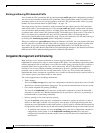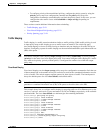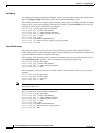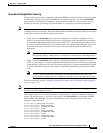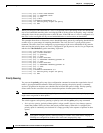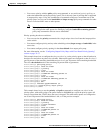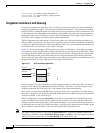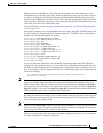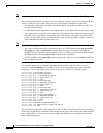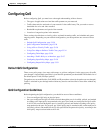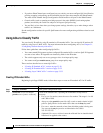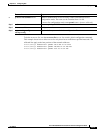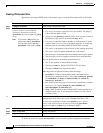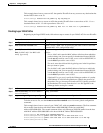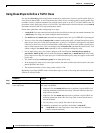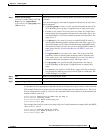
33-28
Cisco ME 3400 Ethernet Access Switch Software Configuration Guide
OL-9639-06
Chapter 33 Configuring QoS
Understanding QoS
Note For optimal performance, we strongly recommend that you configure the queue-limit to 272 or less.
Queue bandwidth and queue size (queue limit) are configured separately and are not interdependent. You
should consider the type of traffic being sent when you configure bandwidth and queue-limit:
• A large buffer (queue limit) can better accommodate bursty traffic without packet loss, but at the
cost of increased latency.
• A small buffer reduces latency but is more appropriate for steady traffic flows than for bursty traffic.
• Very small buffers are typically used to optimize priority queuing. For traffic that is priority queued,
the buffer size usually needs to accommodate only a few packets; large buffer sizes that increase
latency are not usually necessary. For high-priority latency-sensitive packets, configure a relatively
large bandwidth and relatively small queue size.
Note These restrictions apply to WTD qualifiers:
• You cannot configure more than two threshold values for WTD qualifiers (cos, dscp, precedence,
qos-group) by using the queue-limit command. However, there is no limit to the number of
qualifiers that you can map to these thresholds. You can configure a third threshold value to set the
maximum queue by using the queue-limit command with no qualifiers.
• A WTD qualifier in the queue-limit command must be the same as at least one match qualifier in
the associated class map.
This example shows how to configure bandwidth and queue limit so that out-class1, out-class2,
out-class3, and class-default get a minimum of 40, 20, 10 and 10 percent of the traffic bandwidth,
respectively. The corresponding queue-sizes are set to 48, 32, 16 and 272 (256-byte) packets:
Switch(config)# policy-map out-policy
Switch(config-pmap)# class outclass1
Switch(config-pmap-c)# bandwidth percent 40
Switch(config-pmap-c)# queue-limit 48
Switch(config-pmap-c)# exit
Switch(config-pmap)# class outclass2
Switch(config-pmap-c)# bandwidth percent 20
Switch(config-pmap-c)# queue-limit 32
Switch(config-pmap-c)# exit
Switch(config-pmap)# class outclass3
Switch(config-pmap-c)# bandwidth percent 10
Switch(config-pmap-c)# queue-limit 16
Switch(config-pmap-c)# exit
Switch(config-pmap)# class class-default
Switch(config-pmap-c)# bandwidth percent 10
Switch(config-pmap-c)# queue-limit 272
Switch(config-pmap-c)# exit
Switch(config-pmap)# exit
Switch(config)# interface gigabitethernet 0/1
Switch(config-if)# service-policy output out-policy
Switch(config-if)# exit
You can configure and attach as many output policy maps as there are switch ports, but only three unique
queue-limit configurations are allowed. When another output policy map uses the same queue-limit and
class configurations, even if the bandwidth percentages are different, it is considered to be the same
queue-limit configuration.



